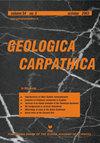加勒比海半内生珊瑚藻石斑藻的初步研究及其进化和生物地理学意义
IF 1.5
4区 地球科学
Q4 GEOSCIENCES, MULTIDISCIPLINARY
引用次数: 0
摘要
半内生珊瑚藻石斑藻(Lithophyllum cuneatum)生长在其表面的宿主中,缺乏对宿主的吸器渗透,以前只在太平洋和印度洋的珊瑚礁环境中为人所知。在这里,我们首次在加勒比海(伯利兹)的珊瑚礁上报告了这一情况。在近海珊瑚礁环境中采集的全新世沉积物岩芯中的加勒比标本的形态解剖特征与太平洋和印度洋报告的模式物质和其他标本的形态解剖学特征相匹配,包括诊断特征的保存(楔形铊形态、概念体及其孔道的形态以及细胞的尺寸)。与印度洋和太平洋全新世的L.cuneatum相似,伯利兹的全新世标本共有两个独特的宿主,分别是珊瑚藻Poroliton onkodes和Neogonioliton sp。该物种在加勒比海的独特分布可以解释为(1)上新世以前从现在的印度洋地区沿着特提斯海道向西扩散,和/或(2)巴拿马地峡仍然开放时,通过太平洋(斐济)向东扩散。尽管形态上等效的珊瑚藻可以属于隐层或伪隐层物种,但这两种情况都意味着谱系的地理分布更广泛、更连续,导致上新世之前的半内生楔形石藻,这与全新世期间更分散的分布形成了对比。尽管在全新世之前缺乏关于楔形乳杆菌地理范围的信息可能与采样偏差有关,并且无法区分这些情况,但以前在海洋无脊椎动物中记录的其他这种不连续分布的情况表明,该物种的地理分布在过去不那么分散,因此支持了特提斯分散假说,包括其现今地理分布的残余特征。本文章由计算机程序翻译,如有差异,请以英文原文为准。
A first account of the semi-endophytic coralline algae Lithophyllum cuneatum from the Caribbean Sea and its evolutionary and biogeographic significance
The semi-endophytic coralline alga Lithophyllum cuneatum, which grows partially embedded in its host on its surface and lacks haustoria penetration to this host, was formerly known only from reef environments of the Pacific and Indian Ocean. Here, we report it for the first time from coral reefs of the Caribbean Sea (Belize). The morphoanatomical characteristics of the Caribbean specimens from Holocene sediment cores, which were collected in offshore reef environments, match those of the type material and other specimens reported from the Pacific and Indian Oceans, including the preservation of diagnostic characteristics (cuneate thallus morphology, morphology of the conceptacles and their pore canals, and dimensions of the cells). Similar to L. cuneatum from the Holocene of the Indian and Pacific oceans, Holocene specimens from Belize share two unique hosts represented by the coralline algae Porolithon onkodes and Neogoniolithon sp. The unique occurrence of this species in the Caribbean Sea can be explained either (1) by pre-Pliocene dispersal toward the west from the present-day Indian Ocean area along the Tethyan seaway and/or (2) by dispersal toward the east via the Pacific (Fiji) Ocean when the Panama Isthmus was still open. Although morphologically-equivalent coralline algae can belong to either cryptic or pseudocryptic species, both scenarios imply a broader, more continuous geographic distribution of lineage leading to semi-endophytic Lithophyllum cuneatum prior to the Pliocene, which is in contrast to the more fragmented distribution during the Holocene. Although the lack of information about the geographic range of L. cuneatum prior to the Holocene can be coupled with sampling biases and cannot discriminate among these scenarios, other cases of such disjunct distributions, which were formerly documented among marine invertebrates, indicate that the geographic distribution of this species was less fragmented in the past, and thus supports the Tethyan dispersal hypothesis, including the relict character of its present-day geographic distribution.
求助全文
通过发布文献求助,成功后即可免费获取论文全文。
去求助
来源期刊

Geologica Carpathica
地学-地球科学综合
CiteScore
2.40
自引率
23.10%
发文量
26
审稿时长
>12 weeks
期刊介绍:
GEOLOGICA CARPATHICA covers a wide spectrum of geological disciplines including geodynamics, tectonics and structural geology, volcanology, stratigraphy, geochronology and isotopic geology, karstology, geochemistry, mineralogy, petrology, lithology and sedimentology, paleogeography, paleoecology, paleobiology and paleontology, paleomagnetism, magnetostratigraphy and other branches of applied geophysics, economic and environmental geology, experimental and theoretical geoscientific studies. Geologica Carpathica , with its 60 year old tradition, presents high-quality research papers devoted to all aspects not only of the Alpine-Carpathian-Balkanian geoscience but also with adjacent regions originated from the Mediterranean Tethys and its continental foreland. Geologica Carpathica is an Official Journal of the Carpathian-Balkan Geological Association.
 求助内容:
求助内容: 应助结果提醒方式:
应助结果提醒方式:


